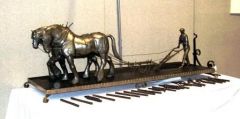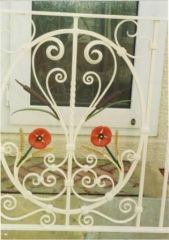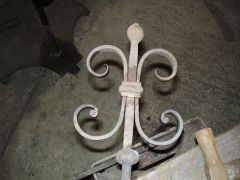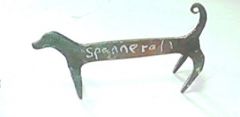-
Posts
3,598 -
Joined
-
Last visited
Content Type
Profiles
Forums
Articles
Gallery
Downloads
Events
Everything posted by John B
-
Hows about using the Nocturnal Iron Works and using an owl as a logo? Easy to forge and you can personalise your forged commissions with one
-
Box spanners were originally tube with the ends forged down to the size required, and a couple of holes drilledthrough at 90 degrees to each other for a tommy bar to fit through to enable the nut to be undone or tightened One way of doing this is to flare the end of an appropriate sized tube then forge it down around a nut/ hex bar of the same size you require it to fit
-
Hi Mark B, the hammer second from the left with the long tapered end and the shorter octagonal end looks very much like a slaters hammer. The smaller end was used to puch a hole through a roofing slate, and the other end was used to hammer in a nail through the punched hole to attach it to the roofing slate battens
-
Another useful source for hot chisels are old worn files, thicker the better,(Old farriers rasps are ideal) I hot cut off the tang end about an inch or so down the blade, (I use this bit to make a handy little scraper for removing welding spatter or paint etc ) and then anneal (normalise)them After annealing, forge the cutting edge to the shape required (flat or curved) sharpen with a hot rasp or whatever, then heat treat this edge by quenching in oil/brine then polish it and draw the temper, this can be done in whatever way you wish, I use the forge or a gas burner played on the top end of the chisel and chase the colour bands down to the tip, quenching at a purplish heat The danger with using the file as a blank is when it is in use, keep the cutting edge cool. I like to dip it in tallow, if you leave it in contact with the red hot workpiece there is a danger that the tip gets warm and if you then cool it in the water trough/bosh it will make the end brittle again
-
-
-
Bottom blast or side blast forge? But as a general guide; Loads of kindling and paper, light a good wood fire with it and when it is going, add the coke on to it. Gentle blast at first until it gets going. It takes a longer period to get to a settled woking temperature What blower are you using? Coke seems to need a constant air blast or it will go out, and some cokes are more difficult to sustain and use than others. Turn off the air blast and it will go out PDQ Some spit, others are not too bad. Fumes seem more toxic if inhaled. Consider mixing some other fuel in with the coke, charcoal works well as it tends to keep the fire in longer when the air is shut down.
-
I am having another go at trying to post a picture of cut out letters and edging attached to a fireback as I indicated in a previous post on this thread
-
In the early seventies I had the dubious pleasure of being involved in refurbishing a 19th century file cutting machine that was still in use by a Sheffield file and tool manufacturer. This was at the time of being made state of the art technology boosting output and consistency of the factory made files, pitch and depths could be adjusted to make the different file grades of cut. While recasting all the white metal bearings and rescraping in slideways etc it was fitted with a new fangled electric motor to replace the flat belt driven shafting run from a waterwheel powered line shaft serving a number of these and other machines. The reason this machine was being refurbished was that it outperformed all the modern machinery that had been made to supercede it. I would like to think its probably still in a working condition somewhere (and not been scrapped due to imports of cheapo foriegn files)
-
Some general comments on Tue irons bore size For normal workshop forging in the old smithy with hand bellows was 7/8" as a guide, some were 3/4" others over an inch tends to depend on workshop and types of work they were regularly doing. The actual blast going through the tue on some of these forges is controlled by a slide valve in a workshop set up to control the size of the fire to be economical on fuel, smaller capacity bellows may not need this facility. I have hand bellows that I use coal on and that has a 3/4" hole through and this is more than adequate for what you will need, and because of the relatively small air capacity of the bellows, a slide/ air control is not needed on a set up like this. I would suggest making the Hole 5/8" diameter to start with, and then open up the hole a fraction at a time if this is not satisfactory, until you reach the size that is. Output from bellows may also be a factor in the size you need, I have made numerous side blast forges, mainly used on coke, and with an electric blower, and slide valve to control air blast, and these have had 5/8" bores in, and we can heat/forge weld up to 2"square no problem What you may have to consider is that when making these tue irons up, is the heat they will be coping with. Normally we construct the tue irons in a water cooled jacket to prevent them rapidly burning away, Even cast iron ones will burn away if worked hard. The pictures show a forge used at St Clem's day at Sticklepath foundry in Devon, made by a local blacksmith, the tue iron hole is about 7/8 in this one, pictures should give an idea of how it is constructed using a water tank to keep the nose cool. Pictures were uploaded, may be in gallery under St Clems day forges/ Glen help please.!!!!
-
I use a twin burner Swan gas forge I had made some years ago before they became a standard item. Quite frankly a single burner would do the jobs I use it for quite adequately, (Collaring, scrolling forging up to 3/4" square) and save on fuel too. Any larger or longer heats and I will use either the coke forge, or if wanting to produce long heats, a triple burner set up I put together when I need it. Heats 6 @ 3/4" square bars to a yellow heat for a 34inch length of heat. Whichever is suitable for the job in hand.
-
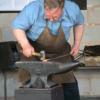
climb milling on the bridgeport , thoughts
John B replied to hdwarner's topic in MIlls, Milling machines, etc
I seem to remember from my apprenticeship (pre cnc) that you needed a milling machine that had a backlash eliminator fitted if you were going to climb mill on it -
Look at 'Numbers on a plate' in the photo gallery (I'm rubbish with a camera, but you may get the idea) (Haven't figured out how to link it to this reply yet) I cut the numbers out of 1/4 plate with o/a, then blind drilled and plug tapped from the rear of the numbers and then attached them with countersunk screws through the backplate. The trick with this is to mark around the position of the letters and drill through the backplate first, then use thes holes as a jig to spot through onto the letters. Did the same to the frame around the edge, you can put any type face you like on, and it doesn't take that long. Paint all parts before assembly, then a last blow over after assembly The finish is a nice clean crisp job.
-
-
-
-
A good cold chisel with curved cutting edge to rock around the shape
-
Hi Glen, Whats an NA Award? If its supposed to be blacksmithing I would expect to make more than a poker. I would suggest going and having a one day taster day or forging experience day to see how you get on, we do them at Westpoint in Devon, but that may be a little far for you to go. Like all courses, its what you do after them that counts Good luck with the interview
-
Well done young lady, excellent start to build on.
-

Price for power hammer please
John B replied to Scot's topic in Power Hammers, Treadle Hammers, Olivers
Condolences Jen Are there any members out there in France who may be able to assist? Not knowing the local situation is a problem, Most powerhammers in the UK would change hands in good condition anywhere in the range of -
Most wheelwrights and wagon makers forges are relatively small in area, the largest items that you would be making I think would be a sweep ring or wheel tires/rims. Traditionally the forge was an area/building attached to the main woodworking side of the shop for safety and finishing reasons. I use a wheelwrights forge that came from a country estate in Devon, It is a water cooled side blast forge, that has quite shallow side, the reason for this being that various diameters of tires and sweep rings can be passed through the fire and supported on the hearth. Most wagon furniture is made as small and light as possible to cut down the overall wight of the wagon it is to be fitted to. i have made fitting for a number of wagons, and really found them an enjoyable challenge, each one being individual. Good luck with the new life and enjoy it.
-

Probably a stupid question about rivets
John B replied to newbiesmith's topic in Blacksmithing, General Discussion
When making tongs I always put the rivet in hot, beat the end down into a head, and then work the handles to free it slightly, then quench in the slack tub whilst still working the handles, I would do the same when setting tongs to any new sizes. Once cooled, the reins should move freely -
make it smaller
-
It may be advisable to drill a small hole at each end of the crack to try and stop it splitting further even when brazed, preheating by use of a large burner head would also help, and a slow cooling rate after the job is done.
-
I would assume it is a sighting board or piece of white card/metal to allow the smith a better view down the bar when examining it for straightness,

